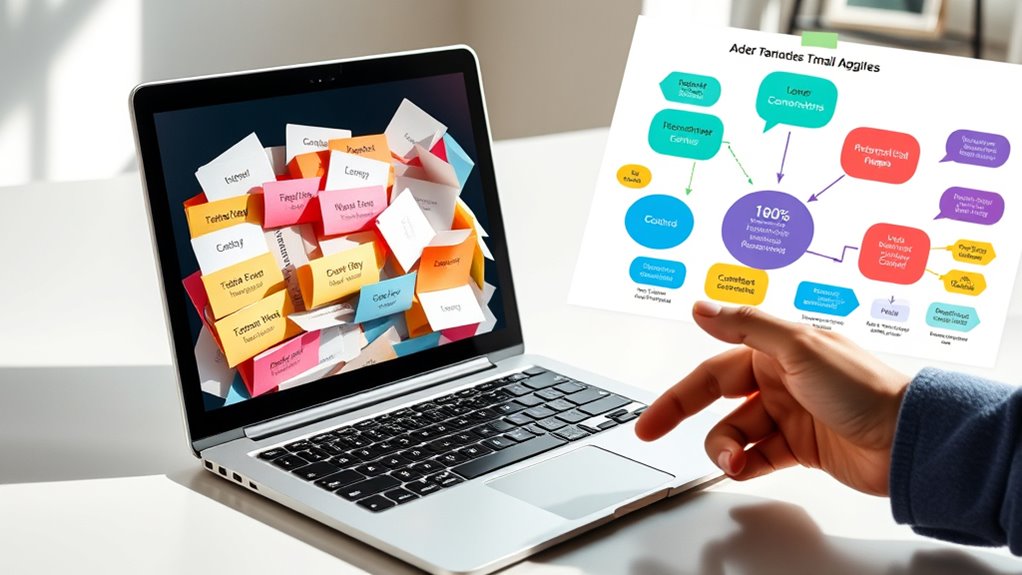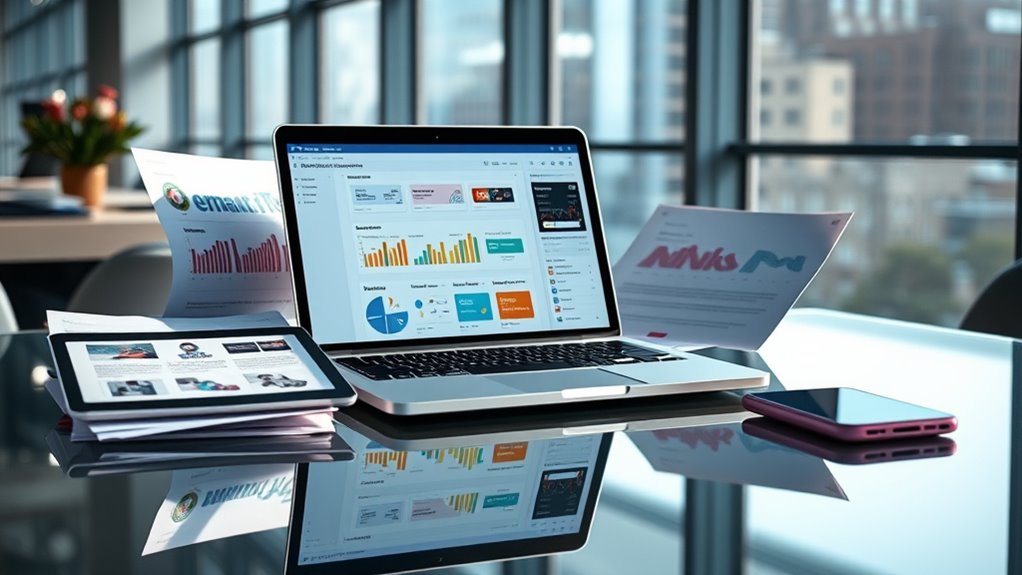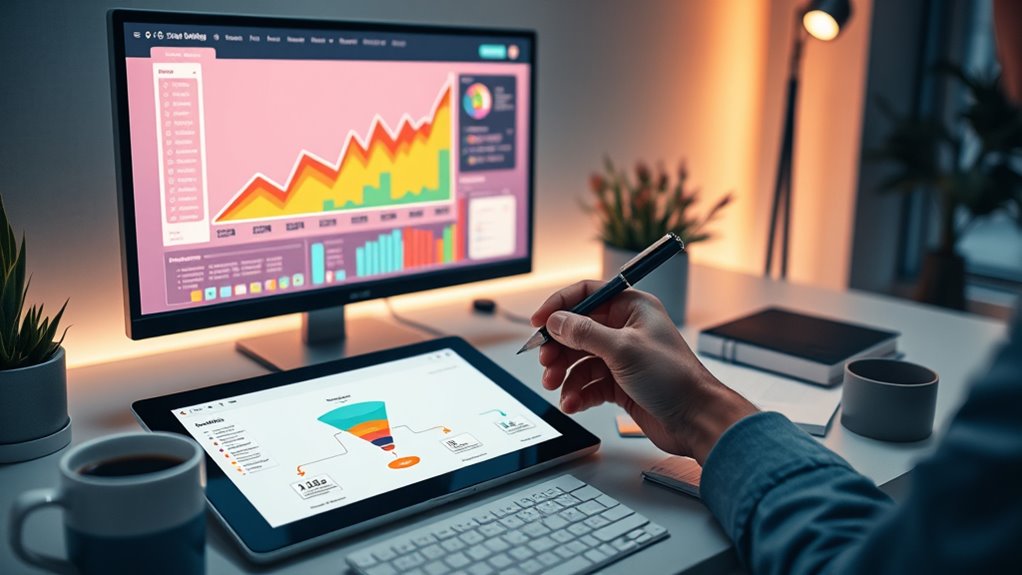Email marketing has evolved from simple list-building to a powerful revenue engine through targeted segmentation, personalized content, and automation. By focusing on nurturing relationships rather than just acquiring subscribers, you can deliver relevant messages that boost engagement and loyalty. Using behavioral triggers, data insights, and multi-channel strategies, you can optimize your campaigns for better results. Want to discover how to turn your email efforts into long-term revenue? Keep exploring to find out more.
Key Takeaways
- Email marketing has evolved from bulk messaging to personalized, targeted campaigns that nurture long-term customer relationships.
- Building a quality subscriber list and segmenting audiences enhances relevance, engagement, and conversion rates.
- Automation and integration across channels enable timely, personalized messaging that aligns with customer journey stages.
- Trust and engagement are strengthened through valuable content, multimedia, behavioral triggers, and tailored follow-ups.
- Measuring campaign metrics and embracing future AI-driven trends ensure continuous optimization while maintaining data privacy.
The Evolution of Email Marketing Strategies

Email marketing has evolved considerably from simple, bulk messages to highly targeted and personalized campaigns. Today, effective email design plays a pivotal role in capturing attention and encouraging engagement. You focus on crafting visually appealing layouts, clear calls-to-action, and concise copy that resonate with your audience. As strategies progressed, subscriber acquisition became more sophisticated, emphasizing quality over quantity. You leverage lead magnets, sign-up incentives, and segmentation to attract the right subscribers and build a loyal list. This evolution means you’re no longer just sending random messages; you’re creating tailored experiences that foster trust and interest. By refining email design and focusing on subscriber acquisition, you set the foundation for more impactful campaigns that drive results, supported by comprehensive review of best practices in content and audience targeting.
Turning Email From a List Builder to a Customer Nurturer

While building a subscriber list is essential, the real power of email marketing lies in nurturing those relationships over time. You need to focus on customer retention by engaging your audience with valuable content and personalized communication. Moving from a list builder to a customer nurturer involves consistent interaction that fosters trust and loyalty. Use this approach to turn new subscribers into repeat customers. Here’s a quick overview:
| Stage | Action | Goal |
|---|---|---|
| List Building | Gather relevant contacts | Expand reach |
| Engagement | Send targeted, helpful emails | Increase trust |
| Customer Retention | Offer exclusive deals, updates | Boost loyalty |
Additionally, incorporating diverse content types such as animated movies, cologne recommendations, or grocery savings tips can keep your audience engaged and interested over time.
The Power of Segmentation and Personalization

Once you’ve started engaging your subscribers with targeted content, the next step is to refine your approach through segmentation and personalization. Customer segmentation helps you divide your audience into specific groups based on their behaviors, preferences, or demographics. This allows you to tailor content that truly resonates. Content personalization takes this further by customizing messages for each segment, making your emails more relevant and compelling. When you send personalized emails, your subscribers feel understood, increasing open and click-through rates. Use data wisely to identify key segments and craft messages that speak directly to their needs. Incorporating mindful decluttering strategies into your email content can also help you better understand your audience’s preferences, leading to more effective engagement. This targeted approach not only boosts engagement but also nurtures relationships, turning subscribers into loyal customers. Segmentation and personalization are essential tools for maximizing email marketing’s effectiveness.
Automation: Streamlining Engagement and Revenue

Automation transforms your email marketing by automatically delivering the right message at the right time, ensuring consistent engagement without extra effort. It streamlines your process, supporting list building and optimizing email design for maximum impact. With automation, you can:
- nurture leads through targeted sequences that adapt based on behavior
- save time by reducing manual follow-ups and repetitive tasks
- refine your email design to match each stage of the customer journey
- boost revenue by triggering timely offers and promotions
- improve color accuracy in your visual content to enhance overall engagement and credibility.
Crafting Compelling Content That Converts

Creating compelling email content is essential for turning your subscribers into customers. To do this, leverage visual storytelling and emotional appeal to resonate deeply. Use vivid images, infographics, or videos that evoke feelings and clarify your message. Craft stories that connect with your audience’s needs and desires, making your message memorable. Here’s an example:
| Visual Storytelling | Emotional Appeal |
|---|---|
| Use images that tell a story | Tap into your audience’s aspirations |
| Incorporate videos that evoke emotion | Address their pain points directly |
| Add infographics for clarity | Highlight benefits that matter |
| Use compelling headlines | Create a sense of urgency or excitement |
This approach keeps your content engaging and persuasive, increasing conversions with each email.
Integrating Email With Other Marketing Channels

Integrating email with other marketing channels amplifies your overall strategy by creating a seamless customer experience. Cross channel integration boosts engagement and reinforces your message across platforms. To maximize multichannel synergy, consider these steps:
- Coordinate messaging to ensure consistency across email, social media, and your website.
- Use email to promote content from other channels, driving traffic and increasing visibility.
- Leverage data from one platform to personalize experiences on others, boosting relevance.
- Automate workflows that trigger actions across channels, maintaining momentum in the customer journey.
- Applying attention to detail in your testing processes ensures that each touchpoint delivers a high-quality experience. This integrated approach guarantees your audience encounters a unified brand voice, deepening relationships and increasing conversions. Remember, the goal is to create a cohesive experience that guides prospects smoothly from awareness to action.
Data-Driven Insights for Revenue Optimization

Harnessing data-driven insights allows you to make smarter decisions that directly boost your revenue. By leveraging customer segmentation, you identify distinct groups within your audience, tailoring messages to meet their specific needs. Predictive analytics then help you forecast future behaviors, such as purchase likelihood or churn risk, enabling proactive strategies. These insights let you optimize your email campaigns, ensuring relevant content reaches the right people at the right time. With a clear understanding of customer preferences and behaviors, you can personalize offers, improve engagement, and increase conversions. Data-driven decision-making transforms your email marketing from guesswork into a precise, strategic tool for revenue growth. Continually analyzing these insights ensures your campaigns evolve, staying aligned with customer needs and maximizing your ROI. Additionally, understanding credit card security is essential to protect customer data and maintain trust.
Leveraging Behavioral Triggers for Targeted Campaigns

You can boost engagement by using behavioral triggers to send personalized messages at the right moments. Timing and context are vital, so you reach customers when they’re most receptive. Implementing these strategies helps create targeted campaigns that feel relevant and timely. Incorporating customer safety considerations ensures that your messaging aligns with product guidelines and builds trust.
Personalized Engagement Strategies
Personalized engagement strategies have become essential for capturing your audience’s attention and driving conversions. By leveraging behavioral triggers, you can craft highly targeted campaigns that resonate deeply. Use dynamic storytelling to create authentic connections, making your messages more compelling. Integrate multimedia elements such as videos, images, and interactive content to enhance engagement. To maximize impact, consider these key approaches:
- Identify specific behaviors that indicate interest or intent
- Tailor content based on user activity and preferences
- Incorporate multimedia for richer storytelling experiences
- Continuously analyze responses to refine your strategy
- Utilize comfort solutions for sofa beds to provide helpful resources that build trust and credibility with your audience.
This approach guarantees your campaigns feel relevant and timely, encouraging recipients to act. When executed effectively, personalized engagement transforms passive recipients into loyal customers, strengthening your revenue engine.
Timing and Contextual Triggers
Timing and contextual triggers are critical for delivering relevant messages precisely when your audience is most receptive. By leveraging behavioral triggers, you can achieve timing consistency, ensuring your emails arrive at ideal moments. For example, sending a follow-up shortly after a purchase or website visit increases engagement and conversions. Contextual relevance enhances the effectiveness of your campaigns by aligning content with a recipient’s current interests or actions. When you understand their behavior—such as browsing certain products or abandoning a cart—you can trigger targeted messages that feel personalized and timely. Recognizing emotional distance and avoidance of intimacy can help you craft messages that address underlying concerns and re-engage your audience. This approach keeps your brand top of mind without overwhelming your audience. Ultimately, mastering timing and contextual triggers helps you build a seamless, responsive email strategy that drives meaningful interactions and revenue.
Measuring Success: Metrics That Matter

To determine whether your email campaigns are truly effective, focusing on the right metrics is essential. The open rate shows how many recipients are engaged enough to open your email, while the click-through rate reveals how many took action. To deepen your understanding, consider these key metrics:
Focusing on open and click-through rates reveals your email campaign’s true effectiveness.
- Open rate — Indicates subject line effectiveness and sender reputation.
- Click-through rate — Measures content relevance and call-to-action success.
- Conversion rate — Tracks how many clicks lead to desired actions or sales.
- Unsubscribe rate — Reflects audience satisfaction and email relevance.
Future Trends Shaping Email’s Revenue Potential

As technology continues to evolve, new trends are emerging that will markedly boost email’s revenue potential. AI integration is transforming personalization, enabling you to craft highly targeted messages that resonate with individual preferences and behaviors. This precision increases engagement and conversion rates, making your campaigns more effective. However, privacy concerns are also on the rise, prompting stricter regulations and consumer protections. To succeed, you need to balance innovative AI tools with transparent data practices, building trust while maximizing revenue. Future email strategies will rely on advanced automation and smarter segmentation, all while respecting user privacy. Staying ahead means adopting these trends thoughtfully, ensuring your email marketing remains both compliant and compelling in an evolving digital landscape. Additionally, understanding privacy and data usage is crucial to navigate the regulatory environment and maintain user trust.
Frequently Asked Questions
How Can Small Businesses Effectively Scale Their Email Marketing Efforts?
To effectively scale your email marketing efforts, focus on segmentation strategies and list building. Segment your audience based on interests, behaviors, or purchase history to send targeted messages that resonate. Continuously grow your list through compelling lead magnets and opt-in incentives. By refining your segmentation and expanding your subscriber base, you’ll boost engagement, conversions, and revenue, transforming your email campaigns into a powerful revenue engine.
What Legal Considerations Should Marketers Keep in Mind With Email Campaigns?
You might think email marketing is straightforward, but legal considerations prove otherwise. You need to prioritize consent management, ensuring recipients opt-in willingly and can easily unsubscribe. Additionally, data security is critical; protecting customer information builds trust and complies with laws like GDPR and CAN-SPAM. Neglecting these legal aspects risks fines and damage to your reputation, so always stay informed and proactive to keep your campaigns compliant and secure.
How Do Emerging Technologies Like AI Influence Email Marketing Strategies?
AI personalization and automation tools revolutionize your email marketing strategies by enabling highly targeted, timely messages. You can automate campaigns to nurture leads efficiently, while AI analyzes data to personalize content that resonates with your audience. This not only boosts engagement but also saves you time. Embracing these emerging technologies helps you stay competitive, optimize conversions, and turn your email efforts into a powerful revenue engine.
What Are Common Pitfalls That Reduce Email Campaign ROI?
Think of your email campaign like a garden; if you don’t weed out irrelevant messages, your ROI suffers. Common pitfalls include neglecting list segmentation, which leads to generic content that doesn’t resonate, and ignoring spam filters that block your messages. You might send too many emails or use tricky language, decreasing engagement. Avoid these mistakes, and your campaigns will thrive, reaching the right audience at the right time.
How Can Brands Balance Personalization With Privacy Concerns?
You can balance personalization with privacy concerns by being transparent about how you use customer data and respecting their preferences. Implement data privacy best practices, such as secure storage and clear opt-in options. Use personalization strategies that focus on relevant, consented information rather than invasive details. This approach builds trust, guarantees compliance, and allows you to deliver tailored content without crossing privacy boundaries, ultimately boosting your email campaign’s effectiveness.
Conclusion
As you continue to refine your email strategies, you’ll find new opportunities to turn your messages into more than just communication—they can gently guide your audience toward loyal engagement and revenue growth. Embrace the evolving tools and insights at your fingertips, and watch your email efforts subtly transform from simple outreach into a powerful, revenue-boosting engine. With each thoughtful campaign, you’re quietly shaping a more connected and prosperous future for your business.









